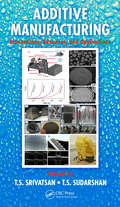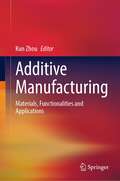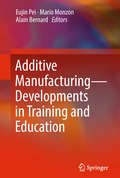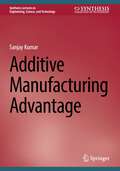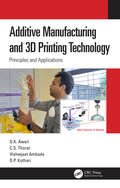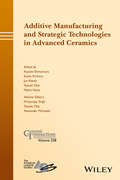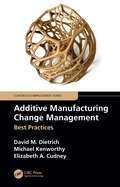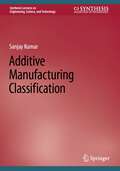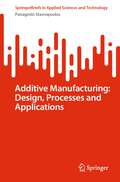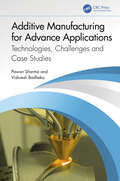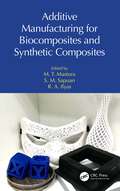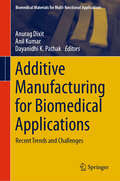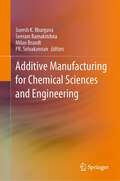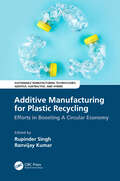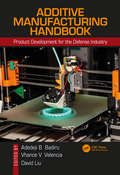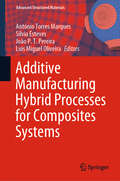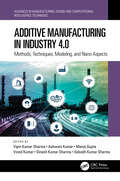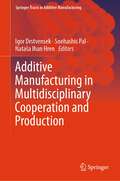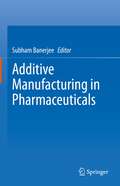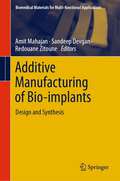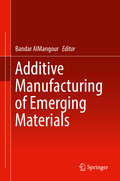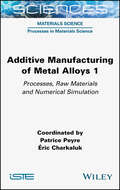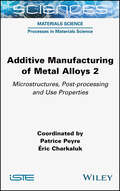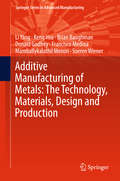- Table View
- List View
Additive Manufacturing: Innovations, Advances, and Applications
by T. S. Srivatsan T. S. SudarshanGet Ready for the Future of Additive ManufacturingAdditive Manufacturing: Innovations, Advances, and Applications explores the emerging field of additive manufacturing (AM)-the use of 3D printing to make prototype parts on demand. Often referred to as the third industrial revolution, AM offers many advantages over traditional manufacturing. This pr
Additive Manufacturing: Materials, Functionalities and Applications
by Kun ZhouThis book focuses on the advances of additive manufacturing in the applications of wearable electronics, energy storage, biomedical implants and devices, drug delivery, and technologies for 4D printing, large-scale printing, and ceramics printing. It provides timely insights into the materials, functionalities, and applications of additive manufacturing.
Additive Manufacturing – Developments in Training and Education
by Alain Bernard Eujin Pei Mario MonzónThis book provides an overview of training and teaching methods, as well as education strategies, for Additive Manufacturing (AM) and its application in different business sectors. It presents real-world applications and case studies to demonstrate the key practical and theoretical fundamentals of AM training, written by international experts from the field. Additive Manufacturing is a rapidly developing technology, and having a well-trained workforce is essential. Accordingly, readers are introduced to new training approaches and recent breakthroughs that can facilitate and accelerate the design, application and implementation of AM.The book’s contributors discuss many topics to provide readers a fundamental grasp of AM, including:· collaboration among educational bodies, and between industry and governments;· strategies for implementing AM training;· new teaching methods;· training programs that provide alternative employment choices;· the need for certification by professional bodies; and· promoting awareness of AM in society. This book offers an excellent source of information for researchers and industrial engineers who are interested in expanding their AM expertise, and learning how to implement it. It will also be of interest to readers who want to learn about the practicalities of adopting training and teaching for AM.
Additive Manufacturing Advantage (Synthesis Lectures on Engineering, Science, and Technology)
by Sanjay KumarThis book provides a concise introduction to additive manufacturing, accessible to anyone with a basic background in engineering and materials science. The author explains additive manufacturing (AM) in terms of advantages and disadvantages and gives a concise list of advantages and disadvantages, enabling readers to understand AM in relation to other techniques. Additionally, this book clarifies various contradictions with the help of numerous examples.This book:Offers readers a unique, accelerated learning tool, revealing the subtleties of Additive ManufacturingDescribes a concept for refabrication in the context of additive manufacturing, providing new insight into repair and refurbishmentDiscusses additive manufacturing not only as a design tool, but also a production tool in the context of mass-production
Additive Manufacturing and 3D Printing Technology: Principles and Applications
by G. K. Awari C. S. Thorat Vishwjeet Ambade D. P. KothariAdditive Manufacturing and 3D Printing Technology: Principles and Applications consists of the construction and working details of all modern additive manufacturing and 3D-printing technology processes and machines, while also including the fundamentals, for a well-rounded educational experience. The book is written to help the reader understand the fundamentals of the systems. This book provides a selection of additive manufacturing techniques suitable for near-term application with enough technical background to understand the domain, its applicability, and to consider variations to suit technical and organizational constraints. It highlights new innovative 3D-printing systems, presents a view of 4D printing, and promotes a vision of additive manufacturing and applications toward modern manufacturing engineering practices. With the block diagrams, self-explanatory figures, chapter exercises, and photographs of lab-developed prototypes, along with case studies, this new textbook will be useful to students studying courses in Mechanical, Production, Design, Mechatronics, and Electrical Engineering.
Additive Manufacturing and Strategic Technologies in Advanced Ceramics: Ceramic Transactions, Volume 258
by Tatsuki Ohji Alexander Michaelis Kiyoshi Shimamura Makio Naito Mrityunjay Singh Jun Akedo Soshu KiriharaThis volume contains a collection of 22 papers submitted from the below seven symposia held during the 11th International Symposium on Ceramic Materials and Components for Energy and Environmental Applications (CMCEE-11), June 14-19, 2015 in Vancouver, BC, Canada: Additive Manufacturing Technologies Advanced Materials, Technologies, and Devices for Electro-optical and Biomedical Applications Multifunctional Coatings for Energy and Environmental Applications Novel, Green, and Strategic Processing and Manufacturing Technologies Powder Processing Technology for Advanced Ceramics Computational Design and Modeling Materials for Extreme Environments: Ultra-high Temperature Ceramics (UHTCs) and Nanolaminated Ternary Carbides and Nitrides (MAX Phases)
Additive Manufacturing Change Management: Best Practices (Continuous Improvement Series)
by David M. Dietrich Michael Kenworthy Elizabeth A. CudneyAdditive Manufacturing (AM) has altered manufacturing as we know it, with shortened development time, increased performance, and reduced product costs. Executive management in industry are bombarded by marketing from their competitors showcasing design solutions leveraged through AM. Therefore, executive management ask their project management teams to figure out how to utilize AM within their own company. Clueless on how to approach the problem, managers start learning about AM from experts and become overwhelmed at the highly technical information. Unlike other AM books that focus on the technical output of AM technology, this new book focuses solely on the managerial implementation. Features Presents the impacts of AM technology Provides engaging, practical, and entertaining "war stories" from the front line of AM industrialization Describes in detail, the significant hurdles in AM certification and implementation Offers templates of proven change management best practices, as practical solutions Omits the technical verbiage that gets in the way of management understanding how the process is implemented
Additive Manufacturing Classification (Synthesis Lectures on Engineering, Science, and Technology)
by Sanjay KumarAdditive manufacturing classification is one of the biggest issues faced by AM community. The book provides a comprehensive classification of AM, which can be useful to anyone working in any area of manufacturing. As the classification depends on the interrelation of various AM processes, the book provides concise and critical information of those processes, which can be helpful to anyone looking for a concise book on AM. The book provides original information unavailable in research papers.
Additive Manufacturing: Design, Processes and Applications (SpringerBriefs in Applied Sciences and Technology)
by Panagiotis StavropoulosThis book is a comprehensive guide to Additive Manufacturing (AM) product development. It offers a practical, reader-friendly approach to integrating the stages of product development. It covers current design and manufacturing strategies with a step-by-step approach, divided into three pillars: design, processes, and applications.The book addresses the challenges hindering the industrial application of AM and provides a roadmap for its successful implementation. It discusses specific AM case studies and hybrid AM cell and production line setups, with the goal of achieving high-quality, low-cost products that are both flexible and productive. The book concludes with an examination of Industry 4.0 capabilities in decentralized manufacturing.It is aimed to be read by researchers and professionals in industry who are interested in the development and potential of additive manufacturing, and will help to lead to wider adoption of AM.
Additive Manufacturing for 8th Sem B.E Mechanical Engineering
by Ravi Kumar. R Prof. Satyabodh M. RaichurAdditive Manufacturing 8th sem B.E. Mechanical Engineering is published by Sunstar publications. The author’s of the book are Ravikumar R, Satyabodh M Raichur. This book highlights essential aspects of sustainability in the Additive Manufacturing (AM). It demonstrates the details of this technology and examines its implications for sustainability throughout the entire product life cycle. The book is divided into 5 modules and provides 2 Model Question papers.
Additive Manufacturing for Advance Applications: Technologies, Challenges and Case Studies
by Pawan Sharma Vishvesh BadhekaThe book discusses the latest trends such as 4D printing, wire arc additive manufacturing (WAAM), direct energy deposition, and topological optimization in additive manufacturing (AM), and its compliance with the ASTM/ISO standards. It further explains materials for additive manufacturing and the development of novel future materials.The focus of this book is to cover the fundamentals, principles, selection of material and equipment, and applications of additive manufacturing (AM) in a comprehensive manner. It will showcase information about the effective utilization of additive manufacturing for advanced applications in diverse areas such as biomedical, aerospace, automobile, defence, and reverse engineering. The other main features are- · Covers comprehensive discussion on the theoretical aspects of additive manufacturing such as sintering, diffusion, and photopolymerization. · Showcases applications of additive manufacturing in diverse fields including aerospace engineering, automotive engineering, biomedical engineering, and reverse engineering. · Presents case studies to showcase real-time problems and solutions using additive manufacturing. · Includes pedagogical features such as algorithms, exercises, and case studies. The text is primarily written for senior undergraduate, graduate students, and academic researchers in the fields of manufacturing engineering, industrial engineering, production engineering, mechanical engineering, and aerospace engineering.
Additive Manufacturing for Biocomposites and Synthetic Composites
by M. T. Mastura S. M. Sapuan R. A. IlyasAdditive Manufacturing for Biocomposites and Synthetic Composites focuses on processes, engineering, and product design applications of bio-composites and synthetic composites in additive manufacturing (AM). It discusses the preparation and material characterization and selection, as well as future opportunities and challenges. Reviews the latest research on the development of composites for AM and the preparation of composite feedstocks Offers an analytical and statistical approach for the selection of composites for AM, including characterization of material properties Emphasizes the use of environmentally friendly composites Analyzes the lifecycle including costs Considers potential new fibers, their selection, and future applications This book provides a comprehensive overview of the application of advanced composite materials in AM and is aimed at researchers, engineers, and advanced students in materials and manufacturing engineering and related disciplines.
Additive Manufacturing for Biomedical Applications: Recent Trends and Challenges (Biomedical Materials for Multi-functional Applications)
by Anurag Dixit Anil Kumar Dayanidhi K. PathakNew fabrication techniques and biomaterials have advanced significantly as attention toward healthcare innovations in recent decades has increased. This book provides a comprehensive overview of the application of additive manufacturing for biomedical devices. The book focuses on the use of biomaterial for hard and soft tissue engineering. These materials can imitate the mechanical, structural, and biological characteristics of the parent tissue, repairing or replacing its functioning. It provides details on the use of various biomaterials for different biomedical applications. It highlights the present trends and potential of various techniques and materials for various applications. The chapters in this book written by eminent experts highlight recent developments in additive manufacturing for biological mimicking and surgical planning. It discusses latest advances in various 3D printing technologies in the fabrication of biomedical devices for orthopaedic and cardiovascular applications, along with rising trends in designing and creating tissue replacement substitute simulants. This book can serve as a fundamental textbook for research in additive manufacturing, fabrication of implants or scaffolds and medical device development, biomaterials, tissue engineering, and biomedical engineering. This book can be a valuable resource for mechanical and biomedical engineers, academicians, healthcare researchers, and professionals interested in tissue engineering.
Additive Manufacturing for Chemical Sciences and Engineering
by Suresh K. Bhargava Seeram Ramakrishna Milan Brandt Pr. SelvakannanThis book is tailored designed for both researchers as well as academics teaching or introducing Advanced Manufacturing course to their classrooms. It presents the current state of research in this field of research and major challenges identified so far, for the integration of additive manufacturing into chemical processes. Unique capability of transforming materials into functional devices with specific geometry using the emerging additive manufacturing technologies has stimulated significant interest in biology, engineering and materials science, to provide custom-made designs for tailored applications. However, the applications of this emerging technology in the field of chemical sciences and engineering have started very recently. Therefore, the major focus of this book is to introduce the basic principles of additive manufacturing practices as well as advent into conventional chemical processes and various unit operations. The potential advantage of introducing these additive manufacturing technologies has the potential to scale down large scale chemical processes into small scale, which offers several advantages including lower foot print, waste reduction and efficient heat integration as well as distributed chemical manufacturing.
Additive Manufacturing for Plastic Recycling: Efforts in Boosting A Circular Economy (Sustainable Manufacturing Technologies)
by Rupinder SinghThis book provides a comprehensive and up-to-date discussion of breakthroughs on additive manufacturing for plastic material recycling to boost a circular economy. It offers new ideas of combining/hybridizing processing methods that work as a source of information for manufacturers in making new and strategic product development plans. Additive Manufacturing for Plastic Recycling: Efforts in Boosting a Circular Economy provides a critical, comprehensive, methodological, and strong state-of-the-art work on the processing of thermoplastic and thermosetting along with new directions and applications. It describes the common and hybrid approaches of recycling processes and includes theoretical and practical ideas of combining/hybridizing processing methods with the use of fused deposition modelling, which is one of the low-cost additive manufacturing techniques. The book also discusses mechanical twin-screw extrusion followed by case studies for developing hybrid composite structures for biomedical and structural applications. Recent innovations in melt processing for recycling and the fundaments, process parameters investigations, and applications for new product development are also presented. This book is a first-hand reference source of information for academic scholars and commercial manufacturers for making strategic development plans for new product development.
Additive Manufacturing Handbook: Product Development for the Defense Industry (Systems Innovation Book Series)
by Adedeji B. Badiru David Liu Vhance V. ValenciaTheoretical and practical interests in additive manufacturing (3D printing) are growing rapidly. Engineers and engineering companies now use 3D printing to make prototypes of products before going for full production. In an educational setting faculty, researchers, and students leverage 3D printing to enhance project-related products. Additive Manufacturing Handbook focuses on product design for the defense industry, which affects virtually every other industry. Thus, the handbook provides a wide range of benefits to all segments of business, industry, and government. Manufacturing has undergone a major advancement and technology shift in recent years.
Additive Manufacturing Hybrid Processes for Composites Systems (Advanced Structured Materials #129)
by António Torres Marques Sílvia Esteves João P. T. Pereira Luis Miguel OliveiraThis book focuses on the emerging additive manufacturing technology and its applications beyond state-of-the-art, fibre-reinforced thermoplastics. It also discusses the development of a hybrid, integrated process that combines additive and subtractive operations in a single-step platform, allowing CAD-to-Part production with freeform shapes using long or continuous fibre-reinforced thermoplastics. The book covers the entire value chain of this next-generation technology, from part design and materials composition to transformation stages, product evaluation, and end-of-life studies. Moreover, it addresses the following engineering issues: • Design rules for hybrid additive manufacturing; • Thermoplastic compounds for high-temperature and -strength applications; • Advanced extrusion heads and process concepts; • Hybridisation strategies; • Software ecosystems for hAM design, pre-processing, process planning, emulating and multi-axis processing; • 3D path generators for hAM based on a multi-objective optimisation algorithm that matches the recent curved adaptive slicing method with a new transversal scheme; • hAM parameters, real-time monitoring and closed-loop control; • Multiparametric nondestructive testing (NDT) tools customised for FRTP AM parts; • Sustainable manufacturing processes validated by advanced LCA/LCC models.
Additive Manufacturing in Industry 4.0: Methods, Techniques, Modeling, and Nano Aspects (Advances in Manufacturing, Design and Computational Intelligence Techniques)
by Vipin Kumar Sharma Ashwani Kumar Manoj Gupta Vinod KumarThe text covers four important areas: digital manufacturing, modern manufacturing processes, modeling and simulation in smart industry, and nanotechnology. It further presents mathematical models to represent physical phenomena and applies modern computing methods and simulations in analyzing the same. The text covers key concepts such as abrasive flow machining (AFM), abrasive water jet (AWJ) machining, and hybrid machining for micro/nanomanufacturing. It will serve as an ideal reference text for senior undergraduate, graduate students, and researchers in fields including mechanical engineering, aerospace engineering, manufacturing engineering, and production engineering. Features Discusses sustainable development aspects of additive manufacturing in industry 4.0 Studies electrochemical machining processes for micro-machining Presents experimental Investigation of friction factor and heat transfer rate in the laminar regime Examines the mechanical and microstructural characterization of titanium chips using large strain machining Covers hybrid approaches like electrochemical machining and magnetic abrasive flow machining The book emphasizes linking the computer interface with the digital manufacturing process and their demonstration using commercially available software like Solid-Edge, ProE, and CATIA. It further discusses important aspects of digital manufacturing, advanced composites, artificial intelligence, and modern manufacturing processes.
Additive Manufacturing in Multidisciplinary Cooperation and Production (Springer Tracts in Additive Manufacturing)
by Igor Drstvensek Snehashis Pal Nataša Ihan HrenThis book publishes the latest findings and ideas in the field of additive manufacturing presented by authors from prominent institutions around the world at the iCAT 2023 conference. The authors address various technological and medical aspects, ranging from materials science to the specific behaviour of the technology under different working conditions. The book is divided into four sections, three of which are dedicated to the purely technological aspects of additive manufacturing, covering metal processes, polymer processes and simulation. The fourth part of the book is dedicated to the medical applications of additive manufacturing, covering areas ranging from orthopaedic surgeries to materials used in medical AM.Overall, the book provides insight into the current state of the science and applications of additive manufacturing.
Additive Manufacturing in Pharmaceuticals
by Subham BanerjeeThis book presents the different 3D/4D printing technological applications of Additive Manufacturing (AM) in Pharmaceutical Sciences. The initial chapter provides the historical perspective and current scenario of AM in pharmaceuticals. The book further discusses about different 3D printing platform technologies such as FDM, SLA, SLS, SSE, Ink-jet & binder jet principles & applications in developing advanced drug delivery systems. It also covers the methodology, materials for AM and important parameters associated with these platform technologies. The book highlights the progress and practical applications of 4D-printing technology in healthcare & pharmaceuticals fraternity as well including the essence of bioprinting in pharmaceuticals. Finally, the book reviews the regulatory guidelines, perspectives, and integration of Artificial Intelligence (AI)/Machine learning (ML) in pharmaceutical AM. This book is indeed a valuable resource for students, researchers/scholars, young start-ups/entrepreneurs, and pharmaceutical professionals by providing thorough detailing about AM in Pharmaceuticals.
Additive Manufacturing of Bio-implants: Design and Synthesis (Biomedical Materials for Multi-functional Applications)
by Amit Mahajan Sandeep Devgan Redouane ZitouneThis contributed volume presents the latest research on additive manufacturing (AM) or 3D printing, one of the key techniques of novel medical devices, which can process complicated or customized structures to match the properties of human tissues. AM allows for the fabrication of devices with optimal architectures, complicated morphologies, surface integrity, and regulated porosity and chemical composition. Various AM methods can now consistently fabricate dense products for a variety of materials, comprising steels, titanium alloys, Co-Cr alloys, metal-based composites, and nanocomposites. This book elucidates the chronology of various techniques that are categorized under additive manufacturing. Moreover, the futuristic techniques or advancements in this area are also described. The available literature focuses on the microstructure and various properties of 3D-printed alloys. However, the research on the wear characteristics, corrosion resistance, and biocompatibility of 3D-printed technology for biomedical applications is limited. This book comprises the helicopter view of different surface analysis trends of additive manufactured alloys. The book can be a valuable reference for beginners, researchers, and professionals interested in bioimplant manufacturing and allied fields.
Additive Manufacturing of Emerging Materials
by Bandar AlMangourThis book provides a solid background for understanding the immediate past, the ongoing present, and the emerging trends of additive manufacturing, with an emphasis on innovations and advances in its use for a wide spectrum of manufacturing applications. It contains contributions from leading authors in the field, who view the research and development progress of additive manufacturing techniques from the unique angle of developing high-performance composites and other complex material parts. It is a valuable reference book for scientists, engineers, and entrepreneurs who are seeking technologically novel and economically viable innovations for high-performance materials and critical applications. It can also benefit graduate students and post-graduate fellows majoring in mechanical, manufacturing, and material sciences, as well as biomedical engineering.
Additive Manufacturing of Metal Alloys 1: Processes, Raw Materials and Numerical Simulation
by Patrice Peyre Éric CharkalukOver the last decade or so, additive manufacturing has revolutionized design and manufacturing methods by allowing more freedom in design and functionalities unattainable with conventional processes. This has generated extraordinarily high interest in both industrial and academic communities.Additive Manufacturing of Metal Alloys 1 puts forward a state of the art of additive manufacturing and its different processes, from metallic raw materials (in the form of powder or wire) to their properties after elaboration. It analyzes the physics and the modelling of existing AM processes as well as future elaboration processes.Using a balanced approach encapsulating basic notions and more advanced aspects for each theme, this book acts as a metal additive manufacturing textbook, as useful to professionals in the field as to the general public.
Additive Manufacturing of Metal Alloys 2: Microstructures, Post-processing and Use Properties
by Patrice Peyre Éric CharkalukOver the last decade or so, additive manufacturing has revolutionized design and manufacturing methods by allowing more freedom in design and functionalities unattainable with conventional processes. This has generated extraordinarily high interest in both industrial and academic communities. Additive Manufacturing of Metal Alloys 2 puts forward a state of the art of additive manufacturing and its different processes, from metallic raw materials (in the form of powder or wire) to their properties after elaboration. It analyzes the microstructures and post-processing of existing AM materials as well as their use properties. Using a balanced approach encapsulating basic notions and more advanced aspects for each theme, this book acts as a metal additive manufacturing textbook, as useful to professionals in the field as to the general public.
Additive Manufacturing of Metals: The Technology, Materials, Design and Production (Springer Series in Advanced Manufacturing)
by Francisco Medina Li Yang Keng Hsu Brian Baughman Donald Godfrey Mamballykalathil Menon Soeren WienerThis book offers a unique guide to the three-dimensional (3D) printing of metals. It covers various aspects of additive, subtractive, and joining processes used to form three-dimensional parts with applications ranging from prototyping to production. Examining a variety of manufacturing technologies and their ability to produce both prototypes and functional production-quality parts, the individual chapters address metal components and discuss some of the important research challenges associated with the use of these technologies. As well as exploring the latest technologies currently under development, the book features unique sections on electron beam melting technology, material lifting, and the importance this science has in the engineering context. Presenting unique real-life case studies from industry, this book is also the first to offer the perspective of engineers who work in the field of aerospace and transportation systems, and who design components and manufacturing networks. Written by the leading experts in this field at universities and in industry, it provides a comprehensive textbook for students and an invaluable guide for practitioners
